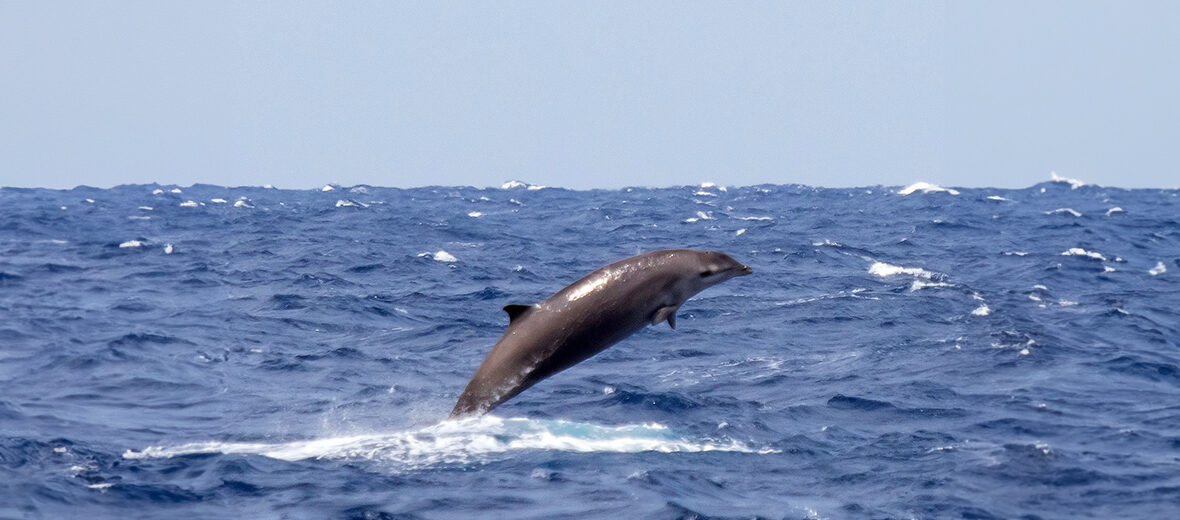
The Gervais’ beaked whale, aka Antillean beaked whale, European beaked whale, or Gulf Stream beaked whale, is the most often stranded mesoplodont whale. Unfortunately, these small whales face the threats of overfishing; climate change that affects their food source; and pollution, including agricultural waste, fuel leaks, and especially plastics and other garbage. These whales are still abundant enough to be listed as Least Concern by the IUCN, but their population trend is unknown.
First the Stats…
Scientific name: Mesoplodon europaeus
Weight: Up to 2,600 lbs.
Length: Up to 17 feet
Lifespan: Up to 48 years
Now on to the Facts!
1.) These whales are rather shy and difficult to photograph and study.
2.) Somewhere between 1836 – 1841, Abel Vautier came across a dead specimen in the English Channel that he brought on board his ship. He removed the head and delivered it to Caen, who presented it to Vautier. In turn, Vautier took the head to the anatomist Deslongchamps. Deslongchamps then brought it to the French scientist Paul Gervais who described it as a new species of whale in 1855.
3.) Decades passed with many claiming the specimen was merely an adult Sowerby’s beaked whale.
4.) The identity of this whale species was confirmed by the findings of 2 specimens from New Jersey, a young male caught near Atlantic City in 1889 and later an adult female found stranded at North Long Branch in 1905.
5.) These are the largest of the mesoplodonts (toothed whales).
But wait, there’s more on the Gervais’ beaked whale!
6.) The 2 teeth of males partially protrude towards the end of their beak, but are barely visible.
7.) Females birth a single calf that can measure up to 6.9 feet in length.
Did you know…?
Gervais’ beaked whales can dive to depths of up to 4,921 feet and can stay submerged for up to an hour!
8.) These whales dwell in smaller sized pods.
9.) They feed primarily on squid, smaller fish, and shrimp.
10.) While subtle, these whales do breach the surface of the water from time to time.
But wait, there’s still more on the Gervais’ beaked whale!
11.) On May 5, 2011, a juvenile female was located dead and beached at Playa Larga in Maunabo in southeastern Puerto Rico. Her stomach indicated the effects of what pollution can do to marine life, as it was filled with 10 lbs. of plastic bags!
12.) They can be found, with some luck, off the coasts of Ascension Island, the Canary Islands, eastern United States, Ireland, western Africa, and northeastern South America.
13.) Gervais’s beaked whales are covered by the Agreement on the Conservation of Small Cetaceans of the Baltic, North East Atlantic, Irish & North Seas (ASCOBANS), and the Agreement on the Conservation of Cetaceans in the Black Sea, Mediterranean Sea, & Contiguous Atlantic Area (ACCOBAMS).
14.) This species is also included in the Memorandum of Understanding Concerning the Conservation of the Manatee and Small Cetaceans of Western Africa and Macaronesia.
Now a Short Gervais’ Beaked Whale Video!
Be sure to share & comment below! Also, check out the Critter Science YouTube channel. Videos added regularly!
Want to suggest a critter for me to write about? Let me know here.
Some source material acquired from: Wikipedia & IUCN
Photo credit: whale_nerd




